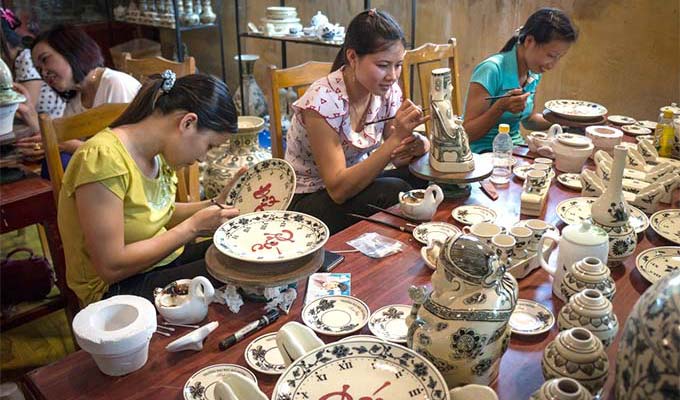After more than 300 years of waning in popularity, Chu Dau is now reviving strongly, becoming a valuable handicraft on both domestic and international markets.

Artisans draw on ceramic products in Chu Dau pottery trade village
Chu Dau pottery, originated in Nam Sach district in the Red River Delta province of Hai Duong, is among the elite Vietnamese pottery genres, flourishing from the 14th to the 17th centuries.
In 1980, Makato Anabuki, former Secretary at the Japanese Embassy in Viet Nam, saw a blue ceramic pot displayed at the Topkapi Saray Museum in Istanbul during a business trip to Turkey. On the jar were written ancient words saying: "The eight Thai Hoa Year (in 1450), made by a potter of the Bui family, from Nam Sach district.” The vase is a national treasure of Turkey and covered by an insurance contract worth millions of US dollars.
Anabuki then sent a letter to Ngo Duy Dong, Secretary of the provincial Party Committee of Hai Hung province (now Hai Duong and Hung Yen provinces) to verify whether the pottery had originated from any local pottery villages.
In April 1986, after eight excavations in Chu Dau village, Thai Tan commune and Minh Tan commune, archaeologists discovered multiple ancient ceramic artifacts, with more than 100 underground pottery oven bottoms.
According to scientists, during wartime, Nam Sach region, including Chu Dau pottery village had been destroyed. Local artisans were forced to move to other regions, establishing new pottery villages.
Then, in 1993 and 1997, Chu Dau potteries were found on a shipwreck offshore of the Philippines and Cu Lao Cham islet in Viet Nam’s central province of Quang Nam. More than 240,000 artifacts were salvaged, most of which were Chu Dau ceramics, showing that the ceramics were also exported to many foreign countries.
Currently, 46 museums in 32 countries around the world have Chu Dau ceramic artifacts on display.
Recognising the significance and value of Chu Dau pottery, the South Hanoi Production, Import and Export Service Company (now the Ha Noi Trade Joint Stock Corporation - Hapro) decided to set up a pottery production facility to restore the ancient ceramic genre, developing it into a high-end ceramic brand, while turning this village into a tourist destination.
In October 2001, Chu Dau Pottery Enterprise (now Chu Dau Ceramic Joint Stock Company) was established. The production base was built on the foundation of the ancient pottery village.
The establishment has invited artists to study the characteristics of Chu Dau pottery, and then instruct local potters. Most of the young workers at that time have now become skilled potters and many of them have been honoured as artisans.
In order to create high-quality products with typical artistic values, the company has focused on reproducing ancient, valuable and unique ceramic samples as well as developed new product lines.
In addition, the company has stepped up trade promotion and expanded markets both in and outside the country. From the first batch of products exported to Spain in May 2003, Chu Dau ceramics have been exported to more than 20 countries in the world and expanded into other Vietnamese localities.
The company’s showrooms and workshops have also become attractive places for tourists and students to experience the process of making pottery, receiving an average of more than 20,000 visitors each year.
Furthermore, it will continuously promote the building of brand, in addition to establishing links between tourism and culture with the traditional handicraft village, making Chu Dau pottery become a major export item of Hapro, with a firm foothold in the domestic market, thus contributing to the promotion of Vietnamese culture.